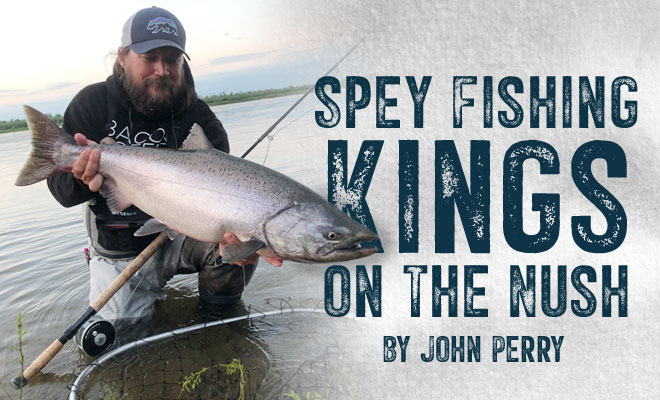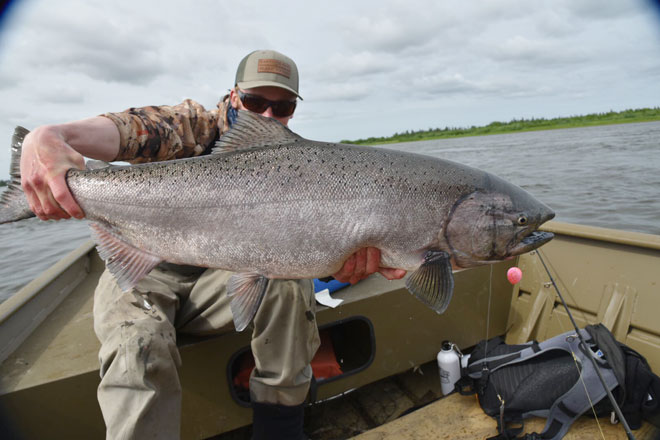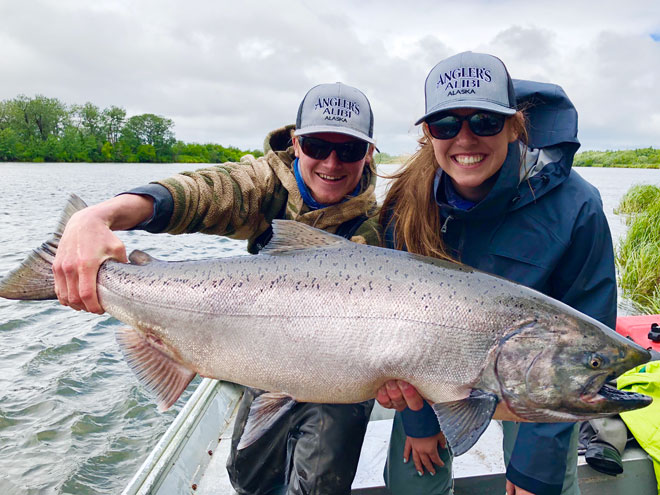King Salmon blog by John Perry, Photos courtesy of Angler’s Alibi

Capt. Chad Bryson with a beautiful king salmon on the fly from the Nusahgak. © Angler’s Alibi
Nushagak River Spey Fishing for King Salmon
For those of you that may not have heard, king salmon fishing on the Nushagak River is literally as good as it can get, period. The king salmon run on the Nushagak River is legendary for not only its sheer numbers, but for its duration over a three-week period that will blow most anglers minds. This river, hands down, receives the largest run of wild king salmon in the world, normally topping the 100,000 mark every season.
Many people fish for the mighty kings during this time period and most will target the kings with conventional tackle, but for some hardy anglers, we prefer to catch them on spey rods with a swung fly. This method is by far the most rewarding way to catch king salmon. The grab you get from a king on a swung fly is addicting. Sure, you will catch a lot more on gear and or bait, but the grab is just not the same.
The historic Nushagak king salmon run peaks between June 18 and July 4 every season. This is the short timeframe we are open for this run and we are in a prime location to intercept fresh kings daily on the tide. The river level in front of camp will rise and fall daily with the tides. It is this proximity to fresh fish that ensures our guests a premium day with short boat rides to the hot spots.

Guide Chris Emmens with a Nushagak fat king caught while drifting. © Angler’s Alibi
The king salmon on the Nushagak average about 20 pounds and are well matched by 9- or 10-weight spey rods in 13- to 15-foot lengths. I prefer to use a longer rod as I feel it turns over long sink tips well. The newer, shorter rods sure do cast nicely, though. The advent of the newer, compact Skagit lines has really allowed for a shorter rod to be used and still hit the very long casts needed to cover a lot of water. We provide our guests with 13-foot Echo King spey rods if they choose to flyfish, matched with Hatch reels which provide a superior drag system kings require. The lines are short, compact Skagit heads ideal for casting 12- to 15-foot sink tips. We use anything from a T-11 to a T-18 sink tip depending on location and current speed. We prefer to utilize seams, points, and shallow crossover areas where kings are more vulnerable to a fly angler. The length of sink tips is really a personal-preference thing and is easily adjusted on the river.
One of the best and most consistent spots in the tidewater section of the Nushagak is right in front of our camp location. We sit just off the confluence of the east and west channel on the west side. This run is very deep below our camp location, but shallows out a bit in front of camp for several hundred yards. This section of river is easily accessible by our guests within a short walk of their wall-tent doors. We have the timing on the tide down to about a two-hour period after high tide at the mouth. This is when the king salmon start to cruise by our camp and are vulnerable to a swung fly.

Allie Jager with guide Chris Emmens grinning with another king on the fly. © Angler’s Alibi
Flies for the Nushagak are really not that different than any other Bristol Bay river. We prefer blue/green/purple combinations as well as black/blue/chartreuse combinations. The intruder-style fly is by far the most used amongst our guests as it creates a nice, big profile in the water with very little drag while casting. The single- and double-style intruders are quite common in the steelhead world. We tie our own flies and also use some custom ties from locals in the Anchorage area. Some of the flies utilize a single, bunny strip tail with a larger head that swims nicely and creates a lot of movement. Blue and chartreuse flies with some flash in silver and pearl are top producers for fresh king salmon, as they resemble herring–a key food for kings in the Bering Sea. Once kings have been in the river for a day or two, a red/orange fly is quite deadly as well as a pink/white combination. Nobody knows exactly why this is, but some speculate the orange and red flies imitate eggs that kings love and the pink/white combinations imitate squid that make up a portion of the king’s saltwater diet as well.
If catching kings on a fly sounds like it might be the experience of a lifetime, there isn’t better place to play the odds than on the Nushagak River. We feel we have tapped into a source here that is like no other and would love to share our location with you this coming summer.
About the author
John grew up in Michigan on Grosse Ile, an island in the mouth of the Detroit River and Lake Erie. It was here, surrounded by great fishing and waterfowl hunting that John developed a passion for the outdoors. John moved to Colorado to chase trout in the summers and ski patrol in the winters. He had the privilege to start guiding for Angler’s Alibi with his fly fishing mentor, TR Rafferty, the second year it was in business. He left a head guide job in Colorado to pursue bigger and better fish.
Over the years he has enjoyed developing lifelong friendships with the guests and witnessing the most consistent, unbelievable fishing this planet has to offer. John has become a passionate spey angler to go along with every other method of fishing styles in Alaska. He will continue to offer a superior level of service to guests at Angler’s Alibi and will keep the fishing program the utmost priority. John has recently added an Angler’s Alibi Nushagak Camp chasing a healthy king run on both spey and single hand fly rods. He resides in Colorado in the off-season with his 2 boys, River and Grey.
View more Fish Alaska blogs here.
